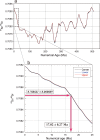87Sr/86Sr age determination by rapidly formed spherical carbonate concretions
- PMID: 30700797
- PMCID: PMC6353912
- DOI: 10.1038/s41598-019-38593-9
87Sr/86Sr age determination by rapidly formed spherical carbonate concretions
Erratum in
-
Publisher Correction: 87Sr/86Sr age determination by rapidly formed spherical carbonate concretions.Sci Rep. 2019 May 7;9(1):7184. doi: 10.1038/s41598-019-40680-w. Sci Rep. 2019. PMID: 31065007 Free PMC article.
Abstract
Isolated spherical carbonate concretions are frequently observed in finer grained marine sediments of widely varying geological age. Recent studies on various kinds of spherical carbonate (CaCO3) concretions revealed that they formed very rapidly under tightly constrained conditions. However, the formation ages of the isolated spherical carbonate concretions have never been determined. Here we use 87Sr/86Sr ratios to determine the ages of these spherical concretions. The studied concretions formed in the Yatsuo Group of Miocene age in central Japan. Some formed post-mortem around tusk-shells (Fissidentalium spp.), while other concretions have no shell fossils inside. The deformation of sedimentary layers around the concretions, combined with geochemical analyses, reveal that Sr was incorporated into the CaCO3 concretions during their rapid formation. Strontium isotopic stratigraphy using 87Sr/86Sr ratios of all concretions indicates an age of 17.02 ± 0.27 Ma, with higher accuracy than the ages estimated using micro-fossils from the Yatsuo Group. The results imply that the 87Sr/86Sr ratio of isolated spherical carbonate concretions can be applied generally to determine the numerical ages of marine sediments, when concretions formed soon after sedimentation. The 87Sr/86Sr age determinations have high accuracy, even in cases without any fossils evidence.
Conflict of interest statement
The authors declare no competing interests.
Figures


References
-
- Raiswell R. The microbiological formation of carbonate concretions in the Upper Lias of NE England. Chemical Geology. 1976;18:227–244. doi: 10.1016/0009-2541(76)90006-1. - DOI
-
- Dix GR, Mullins HT. Shallow, Subsurface growth and burial alteration of Middle Devonian calcite concretions. Jour. Sedimentary Petrology. 1987;57:140–152.
-
- Raiswell R. The growth of Cambrian and Liassic Concretions. Sedimentology. 1971;17:147–171. doi: 10.1111/j.1365-3091.1971.tb01773.x. - DOI
Publication types
MeSH terms
Substances
LinkOut - more resources
Full Text Sources
Research Materials
Miscellaneous

